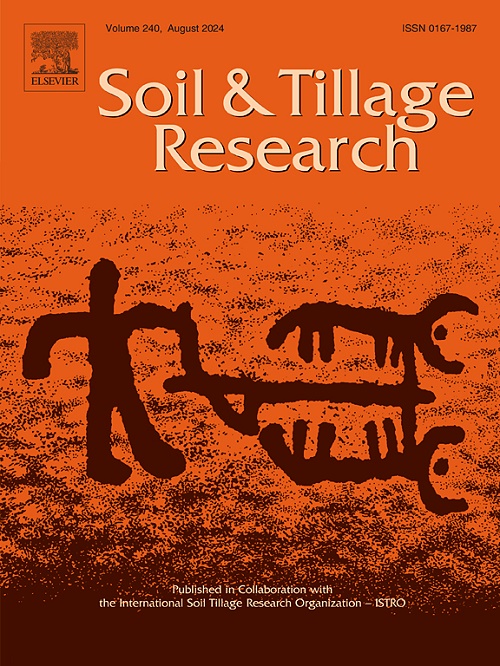近30年来东北黑土区农田土壤颜色变化
IF 6.8
1区 农林科学
Q1 SOIL SCIENCE
引用次数: 0
摘要
种植导致土壤退化,土壤颜色是最直接的指标。这项研究考察了近30年的耕作对土壤颜色的影响。从东北地区农田采集表层土壤样品1273份,得到7种孟塞尔土壤颜色。结合Landsat遥感图像和土壤形成因子,从1990年到2020年每五年进行一次土壤颜色预测。采用逐步分类方法进行建模,分类验证精度在0.61 ~ 0.72之间,总体平均色差为1.60。根据“黑土”的定义,将7种土壤颜色分为黑土颜色和非黑土颜色两类,导致4种类型的变化:持续黑土颜色、积极变化(非黑土颜色向黑土颜色过渡)、消极变化(黑土颜色向非黑土颜色过渡)和持续非黑土颜色。利用现有开垦历史和土壤有机碳(SOC)数据,分析了土壤颜色变化趋势。实验结果表明:1。经过30年的连续耕作,东北地区23.16% %的耕地土壤颜色发生了负向变化;2. 在土壤颜色长期呈负变化的地区,土壤有机碳变化范围为−1.45 g kg−1 ~−3.38 g kg−1,而在土壤颜色长期呈正变化的地区,土壤有机碳变化范围为7.4 g kg−1 ~ 11.68 g kg−1;3. 黑土颜色比例在自然地改田后下降,其中以森林改田后下降最为显著。在耕作11 ~ 15年的地区,黑土颜色的比例平均每5年下降8.09%。土壤颜色变化主要发生在色度维度,其次是价值维度。研究表明,农田复垦对土壤颜色变化有显著影响。为更好地保护黑土,建议采取适当的农业政策和管理措施。研究结果为东北黑土区土壤颜色变化提供了重要参考,并突出了土壤颜色在黑土保持中的重要作用。这些结果为制定有效的土壤管理策略提供了科学依据。本文章由计算机程序翻译,如有差异,请以英文原文为准。
Changes in cropland soil color in Northeast China's black soils region over the past 30 years
Cultivation has led to soil degradation, with soil color being the most direct indicator. This study examined the impact of nearly 30 years of cultivation on soil color. A total of 1273 topsoil samples were collected from cropland in Northeast China, resulting in seven Munsell soil colors. Combined with Landsat remote sensing images and soil formation factors, soil color predictions were made for every five-year period from 1990 to 2020. A stepwise classification method was introduced for modeling, with classification validation accuracy ranging from 0.61 to 0.72, and the overall average color difference was 1.60. Based on the definition of "black soils," the seven soil colors were classified into two groups: black soils color and non-black soils color, leading to four types of changes: consistently black soils color, positive change (non-black soils color transitioning to black soils color), negative change (black soils color transitioning to non-black soils color), and consistently non-black soils color. Using existing reclamation history and soil organic carbon (SOC) datasets, soil color change trends were analyzed. The experimental results show that: 1. After 30 years of continuous cultivation, 23.16 % of cropland in Northeast China experienced negative changes in soil color; 2. In areas of long-term negative soil color changes after 30 years of continuous cultivation, SOC changes ranged from −1.45 g kg−1 to −3.38 g kg−1, while in areas with long-term positive changes, SOC changes ranged from 7.4 g kg−1 to 11.68 g kg−1; 3. The proportion of black soils color decreased after the conversion of natural land to cropland, with the most significant reduction occurring when forests were converted. In areas that had been cultivated for 11 to 15 years, the proportion of black soils color decreased by an average of 8.09% every five years.4. Soil color changes were primarily in the Chroma dimension, followed by the Value dimension. This study shows that cropland reclamation has had a significant impact on soil color changes. To better protect black soils, appropriate agricultural policies and management measures are recommended. The findings provide an important reference for soil color changes in the black soils region of Northeast China and highlight the crucial role of soil color in black soils conservation. These results offer a scientific basis for formulating effective soil management strategies.
求助全文
通过发布文献求助,成功后即可免费获取论文全文。
去求助
来源期刊

Soil & Tillage Research
农林科学-土壤科学
CiteScore
13.00
自引率
6.20%
发文量
266
审稿时长
5 months
期刊介绍:
Soil & Tillage Research examines the physical, chemical and biological changes in the soil caused by tillage and field traffic. Manuscripts will be considered on aspects of soil science, physics, technology, mechanization and applied engineering for a sustainable balance among productivity, environmental quality and profitability. The following are examples of suitable topics within the scope of the journal of Soil and Tillage Research:
The agricultural and biosystems engineering associated with tillage (including no-tillage, reduced-tillage and direct drilling), irrigation and drainage, crops and crop rotations, fertilization, rehabilitation of mine spoils and processes used to modify soils. Soil change effects on establishment and yield of crops, growth of plants and roots, structure and erosion of soil, cycling of carbon and nutrients, greenhouse gas emissions, leaching, runoff and other processes that affect environmental quality. Characterization or modeling of tillage and field traffic responses, soil, climate, or topographic effects, soil deformation processes, tillage tools, traction devices, energy requirements, economics, surface and subsurface water quality effects, tillage effects on weed, pest and disease control, and their interactions.
 求助内容:
求助内容: 应助结果提醒方式:
应助结果提醒方式:


